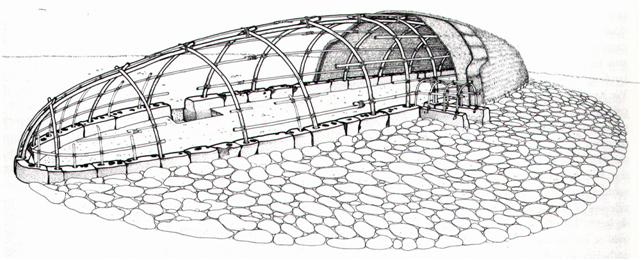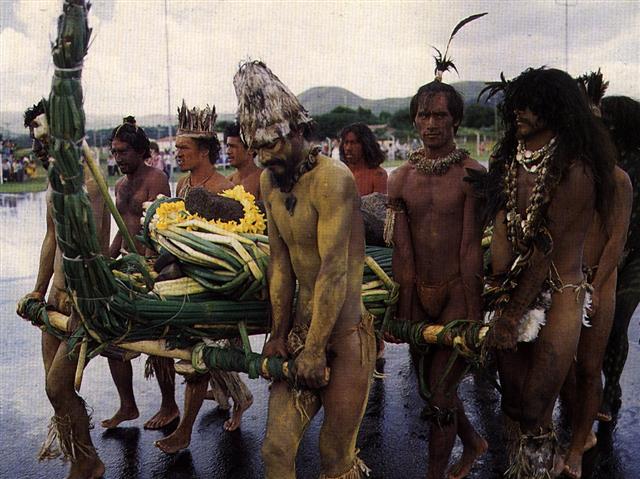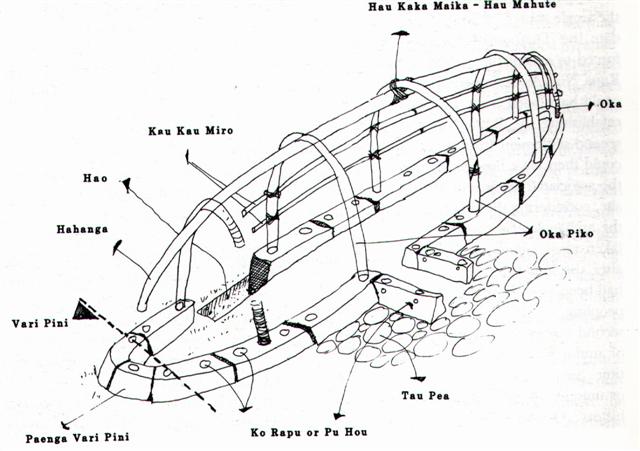According to Manuscript E a boy and a girl were born when the double-canoes had anchored in front of the bay of Hanga Rau: "After Hotu's canoe had anchored, the child of Vakai and Hotu appeared. It was Tuu Maheke, son of Hotu, a boy. After the canoe of Ava Rei Pua had also arrived and anchored, the child of Ava Rei Pua was born. It was a girl named Ava Rei Pua Poki."
Evidently Ava Rei Pua Poki had no father. I remember from my early readings (Thor Heyerdahl, Påskön, en gåta som fått svar.) how they low down among the other stones in the wall of Ahu Naunau in Anakena found a crowned head broken off at the neck, and clearly it was from a stone statue which headless earlier had been brought to Norway. For the Easter Islanders the immediate response to the new discovery was La Reina! - it just had to be their ancient queen Avareipua. Old people cried emotionally:
The royal 'canoes' were no longer running quickly through the 'sea', they had stopped for good. What then had happened after these 'dead' canoes had landed? Were they left on the 'shore'? "After the food supplies had been brought on land, the two rulers, the king and the queen said, 'Drag the canoes on land and take them apart (so the wood can be used) to build houses and cover the roofs!' They dragged the two canoes on land and took them apart. After they had finished disassembling the canoes, Nuku covered all the houses."
On the slopes of Rano Raraku there once was a multitude of 'overturned canoes', dwellings named hare paenga. Van Tilburg: "… nearly the entire outside parameter of Rano Raraku crater is ringed, between 50-75 m contour levels, by evenly spaced hare paenga of overall similar sizes. Nearly all of the structures still retain evidence of attached pavements and most have umu pae associated. Such an order of space and relationship of structures is definitely not coincidental. If these structures were meant to house master carvers, chiefs or priests, those individuals clearly had an agreed-upon pattern of design and location. Since many of the hare paenga appear to be somewhat late in time, probably even after the peak period of statue manufacture, they may represent the presence of the same class of ritual experts who inhabited the similarly-shaped stone houses of Orongo."  ... The most vivid description of hut interiors is given by Eyraud ... who slept in them several nights: Imagine a half open mussel, resting on the edge of its valves and you will have an idea of the form of that cabin. Some sticks covered with straw form its frame and roof. An oven-like opening allows its inhabitants to go inside as well as the visitors who have to creep not only on all fours but on their stomachs. This indicates the center of the building and lets enter enough light to see when you have been inside for a while. You have no idea how many Kanacs may find shelter under that thatch roof. It is rather hot inside, if you make abstraction of the little disagreements caused by the deficient cleanliness of the natives and the community of goods which inevitably introduces itself ... But by night time, when you do not find other refuge, you are forced to do as others do. Then everybody takes his place, the position being indicated to each by the nature of the spot. The door, being in the center, determines an axis which divides the hut into two equal parts. The heads, facing each other on each side of that axis, allow enough room between them to let pass those who enter or go out. So they lie breadthwise, as commodiously as possible, and try to sleep ... The 'half open mussel' is not a bivalve. It should instead of the type which Raven found out in the sea: ... Raven began to search for the girls. For it is the way of things in the world that there are both males and females of every creature. Somewhere there must be girls. Raven searched and searched. Under logs and behind rocks, he looked. But he could not find the hiding place of the first girls. But as he searched, the tide was going out, and as it reached its lowest, the Raven spotted some giant Chitons clinging to the rocks. These giant shell fish had but one shell, fastened tightly to the rocks with huge soft lips around their edges. Raven pried one loose with his beak. And there inside was a girl. He pried off another, and another, and another in each was a girl. They were very similar to the creatures he had found in the clamshell, but more like the Chiton, softer and rounder, in contrast to the hard shell and strong muscles of the clam. And these were just as frightened of the Raven. He gathered them onto his back with difficulty, and brought them to the boys he had found in the clamshell ... Ko Ruti 11 was the first day beyond day 314. According to the calendar from the days of Al Sharatain it was day 288 (= 315 - 27). Here rose for instance Gemma (α Corona Borealis). The first star in the constellation (ο) was rising with the Sun 100 days before the end of the year in the times of Al Sharatain:
The last star in the constellation (ι) arrived 11 days later and in rongorongo times its RA position (242.5) coincided with the number of glyphs on side b of the G tablet (242):
|
||||||||||||||||||||||||||||||||||||||||||||||||||||||||||||||||||||||||||||||||||||||||||||||||||||||||||||||||||||||||||||||||||||||||||||||||||||||||||||||||||||||||||





